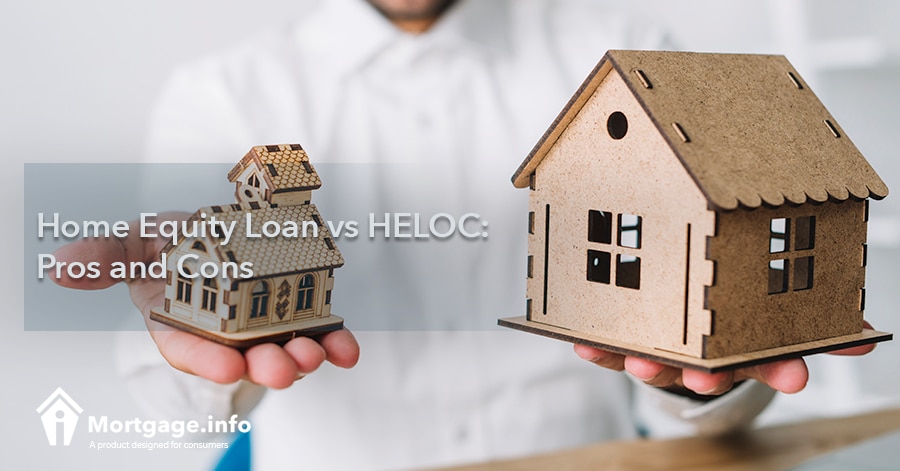
If you have equity in your home, you might be able to take some of the equity out of it. There are several ways to do this – refinance your first mortgage as a cash-out refinance; take out a home equity loan; and take out a home equity line of credit. The first mortgage refinance would leave you with just one loan, but if you do not want to touch the great interest rate you have on that loan, you should entertain the thought of some type of home equity loan. Now the question is how do you determine between the home equity loan vs the HELOC?
Definition of a Home Equity Loan
A home equity loan offers you a fixed amount of money one time. At the closing, you take the full loan amount and do with it what you intended. If the loan contained certain conditions that you must satisfy in order to obtain the funds, the lender will handle the situation. For example, if you have debt to pay off with the funds and it is a requirement of the loan, the closing agent will write checks to the appropriate creditors at the closing. You will not see the cash in your hand in this type of situation.
If you planned a specific repair or renovation with the funds from your home equity loan, you will receive the funds at the closing in order to start the work on your home. You receive the entire amount at one time; the disbursement of the funds is up to your discretion. Most borrowers use this type of loan when they want to repair/replace the roof, add an addition to the home, or remodel a specific room; any type of repairs that take place once as you will not have access to the funds after this one-time disbursement.
Definition of a Home Equity Line of Credit
A home equity line of credit gives you access to the same equity funds; however, you can continually reuse the funds during what is called the draw period. The HELOC works in much the same way as a credit card or other line of credit. The lender approves you for a specific loan amount but you do not receive the funds all at once. You determine how much you take at one time. Generally, the lender provides you with the funds in an account where you have access to withdraw at your discretion with either a “debit” card or a checkbook.
The use of the HELOC is common for borrowers that need continual access to funds, such as making multiple home improvements over the course of a longer period of time or money to start/fund a business. The uses are endless, but you have to let the lender know what you will use the funds for in order to get approved.
Home Equity Loan vs HELOC Payments
When you compare the home equity loan vs the HELOC, the largest difference is how the payments work.
The home equity loan offers two options: a fixed or adjustable rate loan. You make full payments on the entire loan amount for a fixed number of years up to 30 years. If you choose a fixed rate, you make the same payments over the life of the loan. If you choose the adjustable rate loan, you pay an initial interest rate, known as a teaser rate. This payment lasts for a fixed number of years; for example, a 3/1 ARM means the fixed interest rate lasts for the first three years of the loan. After that time, the rate adjusts at a specified time every year and it can adjust up or down.
The home equity line of credit works a little differently in terms of payments. With this loan, you pay only on the amount you withdraw. For example, if your line of credit is $15,000 and you draw $2,000 initially, you only make payments on that $2,000. You also have the option to pay just the interest payment on that $2,000 or you can pay principal and interest. The lender does not require principal payments until the draw period is over, which for most loans is after the first 10 years. You are able to pay back and reuse the principal funds during this time, giving you full access to the line of credit until fully amortized payments begin.
Loan-to-Value Ratio
The maximum loan-to-value ratio allowed on either the home equity loan or home equity line of credit varies by lender. In general, most lenders allow you to borrow up to 80% of the home’s value. So for example, if you have an outstanding first mortgage balance of $175,000 and your home is worth $250,000, you can borrow up to $25,000 with most lenders because 80% of $250,000 is $200,000. Of course, the amount you can borrow depends on your credit, income, employment history, and other compensating factors.
Interest Rates
One thing you should realize about both home equity loans and HELOCs is that the lender will charge a higher interest rate in most cases. The amount they charge you depends on the level of risk you pose to the lender as well as what the lender has to offer. Just like first mortgages, every lender has a different program they can offer you. You should always make the effort to apply with at least 3 lenders to determine which lender offers the most attractive interest rate.
The debate between the home equity loan vs the HELOC boils down to a personal decision for you because there are so many factors involved. Either way, your home is collateral for the loan, so you have to consider your options carefully. Most often, either type of loan offers more lucrative terms than a personal loan or credit card, but understanding what is at stake will help you make the decision that is right for you.
